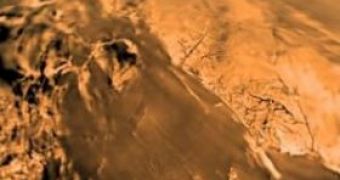Have you ever imagined a tropical paradise at -274 ?F (- 170 ?C)? But on Earth?as such thing does exist on the Saturn's largest moon, Titan, the only moon in the Sun System large enough to have an atmosphere. Methane rainfall soaks dunes of ice or tar on Titan's arid deserts, like a frozen mirror image of Earth's tropics.
"You have all these things that are analogous to Earth. At the same time, it's foreign and unfamiliar," said Ray Pierrehumbert, the Louis Block Professor in Geophysical Sciences at University of Chicago.
His team has compared data on Titan brought by the Cassini space probe and the Hubble Space Telescope with their own computer simulations of the satellite's atmosphere.
"One of the things that attracts me about Titan is that it has a lot of the same circulation features as Earth, but done with completely different substances that work at different temperatures," Pierrehumbert said.
For example, on Titan water is a rock, its liquid role being taken by methane, abundant enough to generate rainfall and form puddles on the Titan's surface.
"The ironic thing on Titan is that although it's much colder than Earth, it actually acts like a super-hot Earth rather than a snowball Earth, because at Titan temperatures, methane is more volatile than water vapor is at Earth temperatures," said Pierrehumbert.
But the "tropical" Titan is located nine times farther from the sun than Earth. Besides methane's behavior, Titan's slow rotation speed also enhances its "tropical" clime. The tropical clime systems of the Earth extend just 30? of latitude from the equator, while on Titan, with one gyration every 16 days, "the tropical weather system extends to the entire planet," Pierrehumbert said.
"Titan's tropical nature means that scientists can observe the behavior of its clouds using theories they've relied upon to understand Earth's tropics," said co-author Jonathan Mitchell.
An updraft emerged where surface winds converge, pushing up evaporated methane to cooler temperatures and lower pressures, where it turns liquid, generating clouds.
"This is a well-known feature on Earth called an ITCZ, the inter-tropical convergence zone," Mitchell said.
Earth's oceans limit the ITCZ to around the Equator, but in the oceanless Titan, computer simulations established ITCZ from one pole to the other, with the clouds following it. But Titan's orange atmospheric haze turns difficult the investigation of its clouds.
"This haze shrouds the entire surface. It pretty much blocks all visible light from reaching us from the surface or from the lower atmosphere." said Mitchell.
Still, infrared techniques have recently showed that clouds are now confined to the Titan's southern hemisphere, which is just ending its summer season.
"There should be a very large seasonality in these cloud features. Cassini and other instruments might be able to tell us about that in the next seven to 10 years or so, as the seasons progress. Over the course of a year, this oscillation in the atmosphere tends to transport moisture, or evaporated methane, out of the low latitudes and then deposit it at mid and high latitude in the form of rainfall. This is interesting, because recent Cassini observations of the surface suggest that the low latitudes are very dry," said Mitchell.
Cassini images detected dunes of ice or tar in the low-latitude areas corresponding to the Earth's tropics. Solar UV light activates methane in the upper Titan's atmosphere and thus byproducts like ethane and hydrogen result, which are bound to hydrocarbon chains that give Titan's orange haze. When they form larger molecules, the hydrocarbons create tar-like rainfall.
"Titan is like a big petrochemical plant. Although this is all happening at a much lower temperature than in a petroleum refinery, the basic processes going on there are very closely allied to what people do when they make fuel." said Pierrehumbert.

 14 DAY TRIAL //
14 DAY TRIAL //